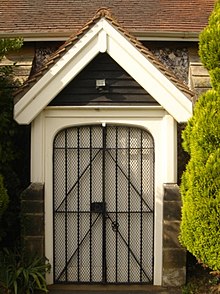St Peter's Church, West Blatchington
Although it has 11th- and 12th-century origins,[1] the church was rebuilt from a ruined state in the late 19th century and extended substantially in the 1960s, and little trace remains of the ancient building.
Like nearby Hangleton, West Blatchington started as an isolated village on the South Downs north of Hove, and had declined to such an extent by the 19th century that only the manor house, the church and some farm buildings and cottages were left.
In particular, the flint walls which survive as part of the present building contain numerous pieces of Roman-era debris, such as fragments of broken tiles and stones from furnaces.
These would have been gathered from the nearby Roman villa in the 11th century when the church was being built: Saxon reuse and recycling of Roman-era building materials and detritus was not unusual.
[1] (The Roman settlement, on a site occupied since the Bronze Age and also containing a few Neolithic artefacts, included ditches, rubbish pits, a cemetery, and kilns for drying corn.
[4] The Scrase family and their descendants had lived in West Blatchington manor for more than four centuries, and were held responsible by some for the failure to restore the church earlier than it eventually was.
Two acres of farmland were needed; these were owned by the main local landowner the Marquess of Abergavenny but farmed by his tenants, the Hobson family (descendants of the Scrases).
[5] Somers Clarke, a Brighton native who was responsible for several church restorations and alterations in the area in the late 19th century, was chosen for the work.
John Leopold Denman was employed as the architect; he built the exterior in flint and retained the old north wall, which helped the extension to fit in well with the 11th- and 19th-century parts of the church.
A chancel was then added during the early Norman era, as were two narrow windows in the west wall of the nave[5] which have been preserved in the present structure.
[15] The parish, which was established in 1940, covers a large area north of Hove immediately west of the Brighton boundary, although much of it is uninhabited downland.


